Structure & Reactivity
Structure Determination with Spectroscopy
UV3. UV-Visible Spectroscopy of Organic
Compounds.
Many of the colours that we see in nature come not
from simple atoms, but from molecules. Organic compounds -- carbon-based
compounds, usually made by living things -- are sometimes very brightly
coloured. If you look out on an autumn day and see a woman in blue jeans
walking beneath an orange maple, then you are observing a couple of organic
compounds.
The blue colour of her jeans is probably indigo, a dye known since
antiquity, but often produced synthetically today. It still has the same
colour, but it is produced by factory workers rather than field hands.
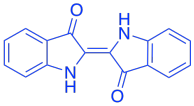
The colour of the
leaves comes from a mix of different compounds such as carotene. Carotene
is a member of a huge class of natural products called terpenoids.

Problem UV3.1.
What colour of light is absorbed
by (a) the blue jeans? (b) the leaves?
In most cases, the reason for the colour is tied to one
phenomenon in these compounds: conjugation. Conjugation is a specific
pattern in the electronic arrangement of molecules. A Lewis structure of a
conjugated molecule shows alternating single and double bonds between carbon
atoms. In some cases, there might also be oxygen or nitrogen atoms
involved in these alternating double and single bonds.
It turns out that conjugation has a very predictable
effect on the energy levels of the electrons involved in those alternating
bonds. It smears out the energy levels. Some of them are pushed a
little higher in energy. Some drop a little lower. Many of them
become spread out in between. As a result, the gaps between those energy
levels becomes smaller and smaller as the amount of conjugation increases in a
molecule.

So, if we start to measure the UV spectra of a bunch
of compounds, we start to see evidence of that conjugation phenomenon from the indigo and carotene. Each time we add a double bond to a conjugated system,
the wavelength of light absorbed increases. It's a significant increase:
maybe forty or fifty nanometers for the first double bond or two that we add in
conjugation, although the differences would get a little smaller if we kept
adding more of them.
| |
λmax (nm) |
| C=C |
170 |
| C=C-C=C |
220 |
| C=C-C=C-C=C |
260 |
Problem UV3.2.
Benzoic acid has an absorption
maximum at 230 nm. Where do you expect to see the absorption maximum in
cinnamic acid?

Problem UV3.3.
P
olyaromatic
systems have rather complicated UV spectra, but as each additional aromatic ring
is added, a shift of about 30 nm occurs in the absorption maximum of the most
prominent peak. If naphthalene has λmax at 220 nm, where
would you see λmax for anthracene and tetracene?

Conjugation is responsible for much of the visible absorption by organic
compounds because the energetic spacing between π and π* orbitals falls
within the same energy range as visible light. As a result, electrons can
be excited from a π to a π* level when that visible light is absorbed.
There are other electrons (other than the ones in the π bonds) that can be
excited by absorption of visible light. If the molecule has sigma bonds,
there is always a possibility of a σ to σ* transition, in which an
electron in a σ bond gets excited to the antibonding level. If the
molecule has lone pairs, there could be n to σ* transitions or n
to π* transitions (n is nonbonding).
However, none of these absorb
light as strongly as π to π* transitions. Just as there were
differences in the strength of absorbances (extinction coefficients) in
transition metal compounds (where MLCT absorbed light strongly, but d-d
transitions absorbed light only weakly), we see large extinction coefficients
for π to π* but only tiny coefficients for σ to σ*
transitions, for example. These differences are related to the spatial
relationships between the two orbitals involved in each case, rather than the
energy differences.

Problem UV3.4.
Organic compounds, like transition metals, can have
absorptions of varying strengths. Consider the following table for
quinone:

| λ (nm) |
ε (cm2 mol-1) |
| 240 |
24 000 |
| 280 |
400 |
| 430 |
20 |
a) Use the data table for quinone to sketch a UV
spectrum.
b) What colour is quinone?
Structures that are very good at absorbing visible light are sometimes called
chromophores. There are plenty of common chromophores in nature,
such as that extended terpenoid structure seen in carotenes; a similar structure
is found in lycopene, which gives tomatoes their red colour.
Quinones are also very commonly seen in chromophores. In humans, the
most common chromophore is melanin; its brown colour is derived from a
quinone-based structure. A different quinone structure, alizarin, is a dye
known since antiquity; it was historically derived from madder root.
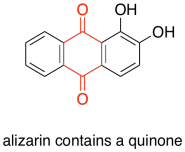
Porphyrins are also very common in humans and other organisms. They are
found in compounds such as hemoglobin, known more for their oxygen-carrying
ability and other indispensible properties than their colour. However,
they are quite brightly coloured. Interestingly, the colours of porphyrins
and other chromophores can be tuned quite easily through variation of side
groups around the main structure. Phthalocyanin green, for example, has
the same porphyrin structure as blood-red heme, but is modified by additional
aromatic rings and chlorine atoms, and contains a copper rather than an iron.
These colour-modifying groups are called autochromes.
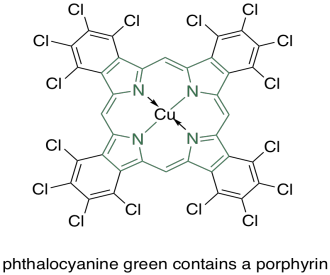
The anthocyanins are another widespread group of naturally-occurring compounds. Like
porphyrins and quinones, they contain a variety of autochromes; the groups
arranged around the central, three-ring structure that forms the essential
chromophore of the anthocyanins. Variations among these side groups leads
to a variety of colours ranging from red to blue. The one shown below gives a purple colour
to the flowers -- petunias -- in which it is frequently found.
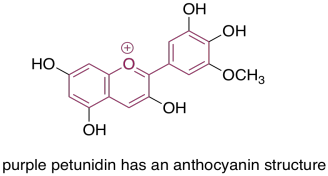
One last group of common chromophores is not found in nature at all.
These are the azo dyes, discovered in the 19th century and still in widespread
use today.

Note that the effects of autochromes can be somewhat complicated in tuning
the absorption of the main chromophore. Not only does the identity of the
side group have an influence (such as the sulfonate group, SO3-,
or an amine group, NH2, in an azo dye), but the group's exact
position is important as well. There is actually a list of rules (Woodward
Rules) that can be used to predict absorption maxima of conjugated systems, but
we won't go into those here.
Problem UV3.5.
In each of the following pigments,
i) circle the main chromophore.
ii) identify the class of chromophore.
iii) predict the observed colour.
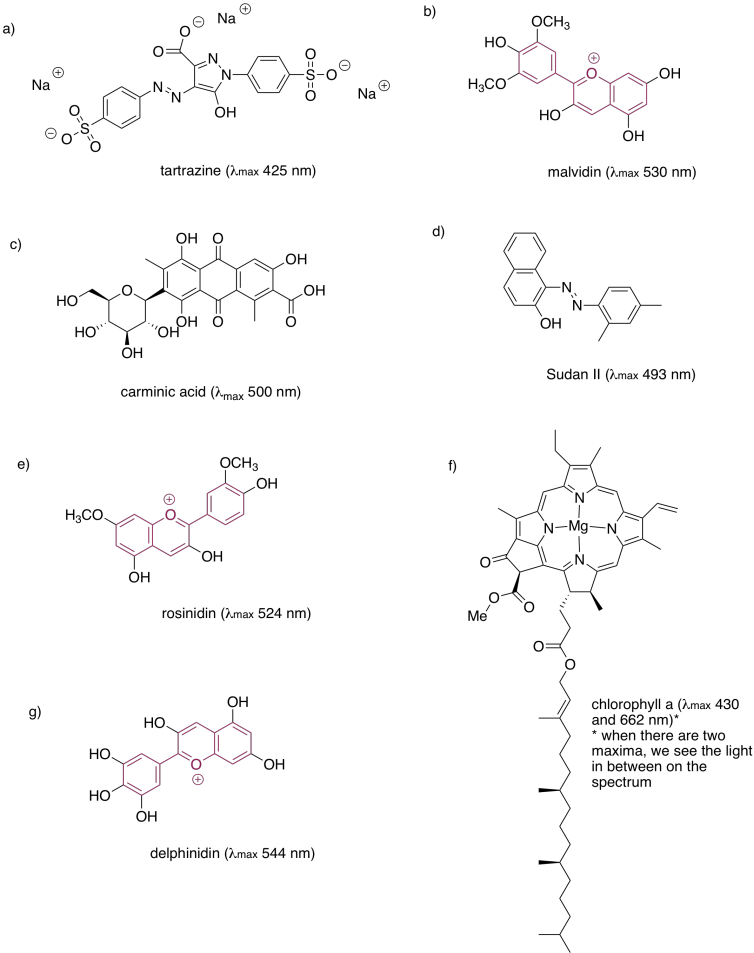
This site is written and maintained by Chris P. Schaller, Ph.D., College of Saint Benedict / Saint John's
University (with contributions from other authors as noted). It is freely
available for educational use.

Structure & Reactivity in Organic, Biological and Inorganic Chemistry by Chris Schaller is licensed under a Creative Commons Attribution-NonCommercial 3.0 Unported License.
Send corrections to cschaller@csbsju.edu
Navigation:
Back to UV
Back to Structure Determination
Back to Structure & Reactivity











